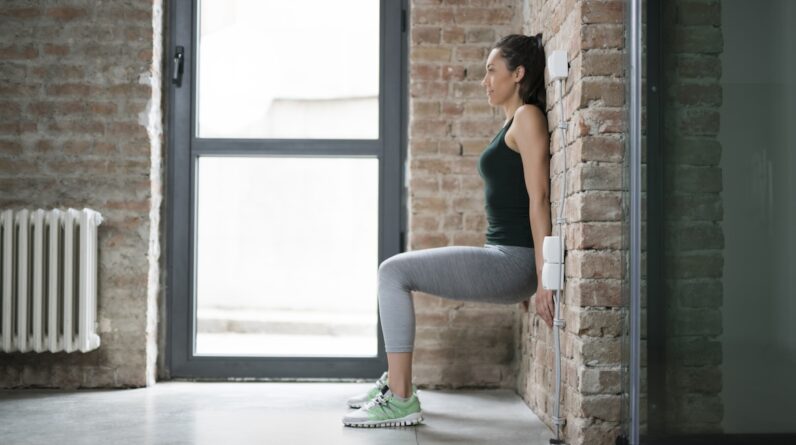
When you come across a fresh patch of powdery snow, what do you do? Obviously, you fall back into it and wave your arms up and down to create a snow angel. Ironically, this childlike delight is quite similar to one of the best exercises you can do to improve your posture: wall angels.
Just trade lying down in the snow for standing up against an empty wall, and you get the general idea. Wall angels work the muscles that move your shoulder blades—your middle and lower trapezius and rhomboids in your back, and your rotator cuffs in your shoulders. They also target the postural muscles in your core that hold your trunk upright, while giving your pecs in the chest a little stretch.
“They’re a very powerful exercise,” says physical therapist Karena Wu, PT, DPT, owner and clinical director of ActiveCare Physical Therapy in New York City.
Although the motion is pretty low-key, wall angels can help give your upper body the strength and mobility it needs to correct a slumped-forward posture. Here’s everything you need to know to work them into your regular routine.
Here’s how to do wall angels the right way
This safe, gentle exercise is fairly easy to implement into your routine at home or as part of a warm-up before a workout. Here’s how to do it correctly.
- Stand with your back up against a wall, your feet just a few inches out and your knees soft. “Your buttocks, your middle back, and the back of your head should be in contact with the wall, as well as, ideally, your elbows and the back of your hands,” Wu says.
- Bend your elbows at 90 degrees and place your upper arms just below shoulder height to start, so they make a “W” position.
- Brace your abdominals to stabilize your core, keeping a neutral arch in your spine.
- Keeping your arms bent, lift your elbows up until they’re above your shoulders and your hands reach up and toward each other.
- Bring your arms back to the start—just like that snow angel.
- Aim for three sets of 10 reps.
Can’t quite nail it? Consider these modifications
1. Wall angel in scapular plane
If your shoulders are too tight do this move with your arms all the way back against the wall, Wu says you can try it in what’s called “the scapular plane,” about 30 to 45 degrees forward in front of the wall. “It’s a little bit easier on the shoulder joint,” she says.
- Stand with your back up against a wall, your feet just a few inches out and your knees soft. “Your buttocks, your middle back, and the back of your head should be in contact with the wall, as well as, ideally, your elbows and the back of your hands,” Wu says.
- With your arms about 30 to 45 degrees forward in front of the wall, bend your elbows at 90 degrees and place your upper arms just below shoulder height to start, so they make a “W” position.
- Brace your abdominals to stabilize your core, keeping a neutral arch in your spine.
- Keeping your arms bent, lift your elbows up until they’re above your shoulders and your hands reach up and toward each other.
- Bring your arms back to the start—just like that snow angel.
- Aim for three sets of 10 reps.
2. Wall angel with smaller range of motion
Alternatively, you could keep the range of motion smaller, not raising your elbows above shoulder height.
“Just do what you can in a comfortable range without forcing it,” says Hannah Solomon, PT, DPT, a physical therapist at the Hospital for Special Surgery. “It shouldn’t hurt.”
3. Wall angel with soft object behind neck
And if your posture is rounded forward so much that you can’t get your head all the way back on the wall, Solomon says an easy adjustment is to put a pillow or a small ball behind your neck—something soft that you can push into.
“Then you’re still getting that same sensation and feedback from the wall, but making it a little bit more accessible,” she says.
- Place a soft object, like a ball or pillow, behind your neck.
- Stand with your back up against a wall, your feet just a few inches out and your knees soft.
- Bend your elbows at 90 degrees and place your upper arms just below shoulder height to start, so they make a “W” position.
- Brace your abdominals to stabilize your core, keeping a neutral arch in your spine.
- Keeping your arms bent, lift your elbows up until they’re above your shoulders and your hands reach up and toward each other.
- Bring your arms back to the start—just like that snow angel.
- Aim for three sets of 10 reps.
The benefits you can get out of doing wall angels
Physical therapists love this exercise for a couple of main reasons:
1. They can help your shoulder function better
When you’re raising your hand overhead, your upper arm bone (the humerus) is supposed to move the first 60 degrees, then your shoulder blade should kick in and start to move with it, according to Wu.
“There’s a coupling motion in the shoulder—it rotates the shoulder blade up and out to the side,” she says.
But that rhythm can be off if your shoulder isn’t functioning properly. Doing wall angels works on that coordination.
2. They can boost your posture
We rarely stand with our backs against a wall in daily life, but this action alone can give us tactile feedback on how we’re holding ourselves up.
“Just standing against the wall sometimes for people, especially if they’re very rounded forward, it’s a reminder of, ‘Oh, this is where I need to be,’” Solomon says.
Once you start doing a few wall angels, the gentle motion activates your upper back muscles and dynamically stretches your chest, giving your trunk what Solomon calls “a postural reset.”
Avoid these all-too-common mistakes
When someone doesn’t have enough shoulder mobility to pull off proper wall angels, Wu says she’ll sometimes see them puff out their chest and arch their middle back.
Other people curve forward, letting their glutes and head lift off the wall. Either mistake has the same consequences: “You’re not working the muscles the right way,” Wu says. Bad form only promotes the same posture that you’re trying to fix.
Solomon says she also sometimes sees people scrunch their shoulders up towards their ears when they raise their arms during this exercise.
“If you’re really elevating in that area, it can make you feel a little bit more tense,” she says.
Fortunately, even if your form is off a bit, you’re unlikely to hurt yourself. Wall angels are safe enough for pretty much anyone to perform on their own, unless you have a shoulder condition or injury.
“Just like with any exercise, though, if you’re having pain or you’re feeling really uncomfortable afterward, maybe it’s not the thing for you and you should see somebody,” Solomon says.
Tips to make the most of the move
To make sure you’re activating your muscles properly, make sure to brace your abdominals the entire time, keeping your core engaged and steady so only your arms at your shoulder joints are moving, Wu says.
That means keeping your elbows bent at 90 degrees, too—if you start to straighten your arms, the work moves into your deltoid and triceps muscles, which won’t help your posture.
You’ll also want to keep your spine long throughout this move.
“I like to tell people to think of being tall from the top of your head, almost like a string is like pulling you up,” Solomon says.
To really encourage strong posture, Solomon uses the wall angel exercise as a warm-up for more intense upper-body strengthening exercises, like rows.
“[The wall angel] is nice to get things moving, start on the right path. And then I usually will have people move on to some additional strengthening exercises,” she says.
Why having good posture is important
So what’s the point of going to all this work to improve your posture? Well, how you hold yourself all day can influence your health in a number of ways.
“Posture can affect neuromuscular function. It can affect your heart, your lungs, your digestion, your metabolism, your mood, and your fatigue,” Wu says.
When your head and shoulders sit too far forward, it puts stress on your spine, and it overstretches certain muscles while allowing others to get overly tight, which can hurt your circulation.
At the same time, it squishes the organs in your trunk, making your heart work harder, reducing your lung capacity, and messing with your digestive tract. Simply put: “Your body’s working in a subpar fashion,” Wu says.
While wall angels on their own probably won’t solve all those problems for you, they can be a healthy habit that gets you one step closer to the kind of posture you’re after.










